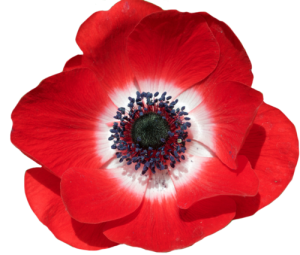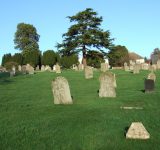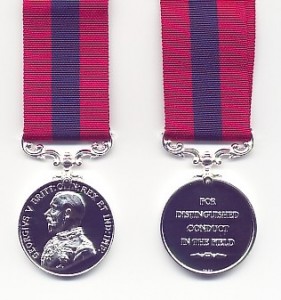Personal Details
Born in Norbury, Cheshire in 1896, the husband of Edith Mabel Groom (nee De Loura) (married in 1917) of 56 The Street, Brecon, Powys, Wales.
Joseph went to France in November 1914 as part of the British Expeditionary Force, serving until 1917. He was awarded the Distinguished Conduct Medal in 1915. In 1917 he volunteered to serve in German East Africa and was sent to East Africa in April 1917, having married the month before. In June 1918 he was posted to West Africa and was on holiday in Welshpool, Powys, Wales with his wife when he was taken ill with blackwater fever, contracted in West Africa, and died at the Buck Inn. He was buried in the cemetery in Brecon, his then home town, with full military honours.
Military Details
Regiment : Nigerian Regiment, West African Frontier Force, formerly 3rd Battalion King’s Shropshire Light Infantry
Rank : Colour Sergeant
Service Number : 9865 (KSLI number)
Died of illness; United Kingdom 7 April 1919 Aged 23
His DCM citation read: "For conspicuous gallantry on the 9th August 1915, during the attack on the Hooge trenches, when he was ordered to reinforce the captured trenches with a machine gun. In the advance he came under heavy shell fire, the gun was damaged and several of the gun team wounded. Although wounded himself, he bound up his comrades' wounds, returned to headquarters and reported, and successfully took another gun and team to the firing line."
The following Whitchurch men were recipients of the Distinguished Conduct Medal :
43987 2nd Cpl. G. G. Wyatt, 16th Div. Sig. Coy., Royal Engineers
Whitchurch, Shropshire – 31 December 1918
11851 Pte. G. M. Sergeant, 6th Bn., King’s Shropshire Light Infantry
Whitchurch, Shropshire – 30 May 1919
67045 Bombardier George Hopwood, 33rd Brigade, Royal Field Artillery
Whitchurch, Shropshire – 3 August 1915
Bombardier J Groom
Sergeant G H Wilson

The 1914 Star (also known as 'Pip') was authorised under Special Army Order no. 350 in November 1917 and by an Admiralty Fleet Order in 1918, for award to officers and men of the British and Indian Expeditionary Forces who served in France or Belgium between 5 August and midnight of 22–23 November 1914. The former date is the day after Britain's declaration of war against the Central Powers, and the closing date marks the end of the First Battle of Ypres.
The 1914–15 Star (also known as 'Pip') was instituted in December 1918 and was awarded to officers and men of British and Imperial forces who served against the Central European Powers in any theatre of the Great War between 5 August 1914 and 31 December 1915. The period of eligibility was prior to the introduction of the Military Service Act 1916, which instituted conscription in Britain.
The British War Medal (also known as 'Squeak') was a silver or bronze medal awarded to officers and men of the British and Imperial Forces who either entered a theatre of war or entered service overseas between 5th August 1914 and 11th November 1918 inclusive. This was later extended to services in Russia, Siberia and some other areas in 1919 and 1920. Approximately 6.5 million British War Medals were issued. Approximately 6.4 million of these were the silver versions of this medal. Around 110,000 of a bronze version were issued mainly to Chinese, Maltese and Indian Labour Corps. The front (obv or obverse) of the medal depicts the head of George V. The recipient's service number, rank, name and unit was impressed on the rim.
The Allied Victory Medal (also known as 'Wilfred') was issued by each of the allies. It was decided that each of the allies should each issue their own bronze victory medal with a similar design, similar equivalent wording and identical ribbon. The British medal was designed by W. McMillan. The front depicts a winged classical figure representing victory. Approximately 5.7 million victory medals were issued. Interestingly, eligibility for this medal was more restrictive and not everyone who received the British War Medal ('Squeak') also received the Victory Medal ('Wilfred'). However, in general, all recipients of 'Wilfred' also received 'Squeak' and all recipients of The 1914 Star or The 1914/1915 Star (also known as 'Pip') also received both 'Squeak' and 'Wilfred'. The recipient's service number, rank, name and unit was impressed on the rim.
Further Information
Report in The Brecon County Times 17 April 1919 regarding the death of Joseph Groom
“The death took place at Welshpool on the 5th inst., under peculiarly sad circumstances of Regimental-Sergt.-Major Joseph Groom, of the 1st Battalion Shropshire Light Infantry. Only 23 years of age when he died, Sergt.-Major Groom had a wonderful war record, yet a record such as one would expect of a soldier who was known in his regiment for his dash and bravery and was esteemed accordingly by all ranks. When the war broke out the deceased, then a sergeant, was stationed with his battalion in Tipperary. He went to France with his unit as part of the original British Expeditionary Force, and was there till the beginning of 1917. During those fateful two and a half years he was twice wounded and won the Distinguished Conduct Medal; and also helped to prove the adaptability of the British soldier by ranking as a first class machine-gunner. Transferred to home service as a staff-sergeant, he was not long content, and volunteered to serve in German East Africa, where he was sent in April, 1917. There he was once more wounded, and during twelve months’ hard service was advanced to the rank of company-sergt.-major. He came home again in April, 1918, on two months’ leave; but by June was on his way to West Africa. Whilst there he was promoted regimental-sergt.-major, after nine years service with the Colours – (he joined as a boy) – and once more returned home at the end of February last.
In March, 1917, he married at Pembroke, Miss Edith Mabel Delonra, of Brecon. He and his wife were spending part of a holiday at Welshpool, where on the 5th inst. he was suddenly taken ill. He died on the 7th inst., of blackwater fever, contracted in West Africa.
On Wednesday, the 9th inst., after a short service at the house, the body was taken with military honours to Welshpool station for conveyance to Brecon. A large number of local service men home on leave marched to the station, and the greatest possible respect was shown by the inhabitants.
The funeral took place at Brecon on Friday afternoon, with full military honours. Troops from the Brecon Depot attended under the command of Lieut. Parry, and the band of the 2nd Battalion South Wales Borderers (conducted by Mr. C. Fenner, L.R.A.M.) played Chopin’s ‘Marche Funebre’ and the ‘Dead March’ from ‘Saul’ on the way to the cemetery. The Rev. H. J. Church Jones took the burial service, and at the close the usual volleys were fired over the grave and the ‘Last Post’ was sounded to band accompaniment.
The chief mourners were the widow; Mr and Mrs Parker, Malpas, Cheshire, brother-in-law and sister; Mrs Mytton, Welshpool, sister; Mrs Delonra, Brecon, mother-in-law; Mrs Morris, Brecon, sister-in-law; Pte W. and Mrs Thomas, brother-in-law and sister; Mrs Jack Williams, Brecon, sister-in-law; Master Harry Delonra, brother-in-law; Mrs Power, Brecon and Mr W. Power, aunt and cousin; Pte J. Morris, Pte Prosser, and Mr and Mrs Cliff, Brecon.
Wreaths were sent by the following – The widow, Mr and Mrs Parker, Mrs Mytton, Mrs Delonra and family, the Sergeants’ mess at the Brecon Depot South Wales Borderers, Mrs Power and son, Mrs Jack Williams, Mrs Morris, Mr and Mrs Cliff, Pte W. and Mrs Thomas, Miss Gladys Delonra, Miss Dora Hargest, Master Steve Thomas, master Jim Morris and Master Dorie O’Shea.”
The Brecon County Times 17 April 1919
More information about Joseph Groom is available from Brecon Remembers.
If you can provide any further information on Joseph Groom please get in touch by leaving a comment below, using our Contact Form or by calling in to Whitchurch Heritage Centre.
Information provided by Whitchurch Museum and Archives



